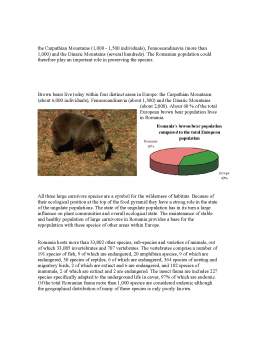Cuprins
- Overview
- Geographical Location and Climate
- Romania as a Spot of Biological Confluence
- Ecosystems Diversity
- Species Diversity
- Human Influence on the Landscape
- Economically Important Wild Species
Extras din referat
Overview
As a consequence of its geographical location and evolution of the human society in the region, Romania has a unique and high level of biodiversity and intact ecological systems. The vast reed beds of the Danube Delta, the high density of large carnivores and the extensive forests covering the Carpathian Mountains are some of the most significant and best known aspects attesting Romania's biological richness.
As much as 47% of the country's surface bears natural and semi-natural ecosystems. Since almost half of the Romanian forests (covering about 13% of the country) have been managed considering watershed conservation rather than production, Romania still has one of the largest areas of undisturbed forest in Europe. The natural integrity of Romanian forest ecosystems is indicated by the presence of the full range of European forest fauna, including 60% and 40% respectively of the European brown bear and wolf populations. Europe's largest wetland, the Danube Delta, lies predominantly in Romania, as well. Major grasslands, caves and an extensive network of rivers add to the country's ecosystem richness.
A matter of national as well as wider European importance Romania's territory is a confluence area between biogeographical regions such as the arctic, alpine, Western and Central European, Pannonic, Pontic, Balkanic, sub-Mediterranean, and even Eastern Colchic, Caucasian and Thuranic-Iranian regions. The high level of geographical diversity in Romania and the consequence of being a place of biological confluence have resulted in a floral diversity including more than 3,700 species, and a fauna diversity estimated to more than 33,802 species. These figures include a large number of endemic and subendemic plants (228) and animals (1,000) adapted to the specific local conditions, and only occurring in Romania. Species that once thrived in many parts of Europe either occur only in Romania nowadays, or can be found in large or significant populations in Romania.
Although rich in biological resources and important as a corridor for the movement of species (biogenetical material), Romania resented the consequence of human activity. Pollution, river damming, hydrotechnical works, industrial agriculture, the overexploitation of natural resources, among other factors, have each had their particular role in decreasing the biodiversity. Inappropriate forms of tourism and associated infrastructure development also threaten the highly sensitive mountain ecosystems. This trend is likely to increase unless adequate measures to reduce the effects of pollution and economic pressures related to the overexploitation of natural resources will be undertaken. Taking into account these particularly significant problems, Romania has an active governmental and non-governmental commitment to reverse the trends of biodiversity loss. A large number of areas (4.8% of the country's land area) have been designated as protected areas. However, a co-ordinated and effectively managed system of protected areas does not exist and institutional capacity for nature conservation and protected area management have not been clearly defined as of yet.
In order to address these shortcomings, Romania has adopted the National Strategy and Action Plan for biological diversity conservation and sustainable use of its components, both of which integrate the principles and objectives of the Convention on Biological Diversity, of the most significant conventions in the field of nature and biodiversity conservation as well as the Pan-European Biological and Landscape Strategy.
Geographical Location and Climate
Romania is located in Central Europe, halfway between the North Pole and the Equator, and also halfway between the Atlantic Ocean and Ural Mountains. The total area of the country is 23,839,100 ha. The elevation of the country varies significantly, e.g. the Danube Delta is located at the sea level while the highest peaks of the Carpathian Mountains rise to over 2,500 m above the sea level.
Preview document
Conținut arhivă zip
- Romania's Biodiversity.doc























